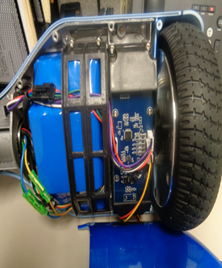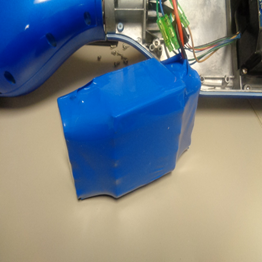The Department of Transportation's (DOT) Pipeline and Hazardous Materials Safety Administration (PHMSA) has identified safety concerns with the transport of "hoverboards" also known as balance boards, gravity boards, or self-balancing devices that contain lithium batteries. Recently, PHMSA investigators intercepted 32 cargo containers filled with hoverboards containing lithium batteries that were improperly prepared for shipment as a hazardous material. Of particular concern, PHMSA's investigation determined that more than 80% of the shippers were unable to produce valid test reports as required by Section 38.3.2.1.1 of the United Nations (UN) Manual of Tests and Criteria. Testing of lithium batteries under this standard is required by U.S. regulation for transportation2.
Generally, cargo shipments of hover boards and similar devices should be classified as "UN3171, Battery-powered vehicles, Class 9." Further, the lithium batteries in the hover boards must be tested in accordance with the UN Manual of Tests and Criteria to ensure that they have been properly manufactured, and packaged to maintain integrity during transport. Transporting these vehicles as cargo without complying with Hazardous Materials Regulations (HMR; Title 49 Code of Federal Regulations Parts 171-180) requirements can carry large civil penalties and, for willful violations, potential criminal liability.
PHMSA is working together with the U.S. Consumer Product Safety Commission (CPSC) to further understand the risks that these products pose. CPSC is investigating the most recent incidents associated with the lithium batteries in hoverboards. The CPSC issued guidance3, recommending consumers not charge hoverboards overnight or while unattended. They also recommend consumers look for a certification label from a national safety testing laboratory on the product before purchase.
Lithium batteries can pose a risk in transportation if they are not manufactured and packaged to the correct specifications. Lithium batteries may become an ignition source when a battery is short circuited, is overcharged, is heated to high temperatures, is mishandled, or is manufactured with defects. If damaged, some lithium batteries may release a flammable electrolyte mixed with other flammable gas compounds. Temperatures of up to 1600 degrees Fahrenheit have been observed in fires during testing conditions. Under certain conditions, lithium batteries can pose a heat, fire, and explosion risk.
PHMSA's Shipping Guidance
The HMR provides requirements on how to properly ship lithium battery-powered vehicles by highway, rail, vessel and aircraft. The regulations also provide requirements on how to transport this type of equipment as an airline passenger or crewmember. Below is a summary of PHMSA's regulations regarding lithium battery transport:
Transport by Shippers and Carriers as Cargo
- When the batteries are installed, these vehicles must be described as "UN3171, Battery-powered vehicles, Class 9".
- Batteries must be securely attached in the vehicles and protected against damage or short circuits.
- Shipments are subject to the HMR. Specifically, in accordance with 49 CFR § 173.220(d):
- For transport by highway and rail, shipments are excepted from all requirements except for testing;
- For transport by aircraft, shipments are subject to the requirements applicable to testing, shipping papers, emergency response information, notification of pilot-in-command, general packaging requirements; the general requirements specific to air transportation in § 173.27; and
- For transport by vessel, shipments are excepted from all requirements except testing, shipping papers, and general packaging requirements.
- For transport by highway and rail, shipments are excepted from all requirements except for testing;
Transport by Airline Passengers and Crew Members
- Passengers who wish to travel with these vehicles should check the airline's websites before travelling because many airlines have banned these items in both carry-on and checked baggage.
- Airlines can choose to allow vehicles that meet the requirements of § 175.10 in checked baggage, restrict them to carry-on baggage only, or refuse carriage altogether.
- The batteries contained in hoverboards likely exceed 100 watt-hours (Wh) and would require approval of the airline. In some cases the batteries may exceed 160Wh, in which case they would not be permitted as checked or carry-on baggage in accordance with § 175.10.
For more information about the appropriate shipping and handling of lithium battery, you can visit PHMSA's website at: http://phmsa.dot.gov/safetravel/batteries or contact PHMSA's Hazardous Materials Information Center (HMIC) toll-free at 1-800-467-4972 or at 202-366-4488. For information specific to air transportation of portable recreational vehicles powered by lithium ion batteries, visit: http://www.faa.gov/go/packsafe/.
 Picture of Hoverboard
|
 Picture of Lithium Battery Installed within Hoverboard
|
 Picture of Lithium Battery Removed and Tethered to a Hoverboard
|
1 UN Manual Section 38.3.2.1, states "All cell types shall be subjected to tests T.1 to T.6 and T.8. All rechargeable battery types, including those composed of previously tested cells shall be subjected to tests T.1 to T.5 and T.7. In addition, rechargeable single cell batteries with overcharge protection shall be subjected to test T.7. A component cell that is not transported separately from the battery it is part of needs only to be tested according to tests T.6 and T.8."
2 See 49 CFR §173.220(d).
